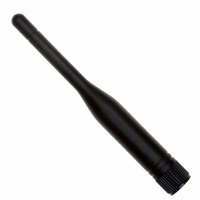0600-00030 Laird Technologies, 0600-00030 Datasheet - Page 45

0600-00030
Manufacturer Part Number
0600-00030
Description
ANTENNA 915MHZ 1/4WAVE 3.5"RPSMA
Manufacturer
Laird Technologies
Specifications of 0600-00030
Antenna Type
Whip: 1/4 Wave, Fixed
Number Of Bands
1
Frequency
902MHz ~ 928MHz
Vswr
2
Gain
1dBi
Termination
RP-SMA
Mounting Type
Connector
Height (max)
3.5" (88mm)
Dimensions
3.5 in L
Technology Type
1/4 Wave Wireless Transceiver Antenna
Termination Style
RPSMA
Lead Free Status / RoHS Status
Lead free / RoHS Compliant
Lead Free Status / RoHS Status
Lead free / RoHS Compliant, Lead free / RoHS Compliant
Appendix III – API
seed range.
81h 01h 08h 04h FFh FFh FFh AAh
Radios A, B, C, & D receive the packet and send it to the OEM Host in the following format:
*
81h 01h XXh XX
h 01h 23h 45h AAh
Advanced
For a more intelligent network, a Time Division Multiple Access (TDMA) system could be implemented. In this system
various radios transmit data to a shared radio during an assigned time interval. The system is synchronous so when a
radio is transmitting it is the only one and has full access to the shared radio’s bandwidth. To utilize a TDMA system a
radio must store its data for the period of time between its transmissions or bursts. A typical format for data passing
through a shared radio is shown below. A frame consists of arriving bursts from remote radios being served. Each frame
is then divided into multiple time slots. The bursts do not have to have the same durations and can be longer for heavy-
traffic stations. To prevent overlaps, guard intervals can be inserted to absorb small timing errors in burst arrivals.
Implementation:
1. Server sends broadcast packet which includes sync pulse.
2. Remote radios hear the sync pulse and join the session
3. Radio A transmits data during time interval t = 1
4. Radio B transmits data during time interval t = 2……..
5. Radio N transmits data during time interval t = N -1
This type of implementation requires careful planning and should allow enough time for each radio to retry if necessary.
If Full Duplex is enabled, the radio which initiates the session will transmit during the even numbered hops while the
remote radios will transmit during the odd numbered hops.
IV. Polling Network
The Transmit and Receive API commands can be used for
applications where it is necessary for one unit to poll several
others for data. The radio requesting the poll can use the Transmit
API command to dynamically switch from one radio to another.
The remote radio will receive the poll request and transmit the
appropriate response to the polling radio.
If the Receive API
feature is enabled, the polling unit will send the remote response
to the OEM host which can then determine the MAC address of
the sending radio and relay the information as needed. Once the
polling radio is finished communicating with the remote radio, the Transmit API command can once again be used to
change the destination address. This process continues until all radios have been successfully polled.
1.
Master to radio A using TX API:
81h 01h 08h 04h 12h 34h 56h AAh
45


















